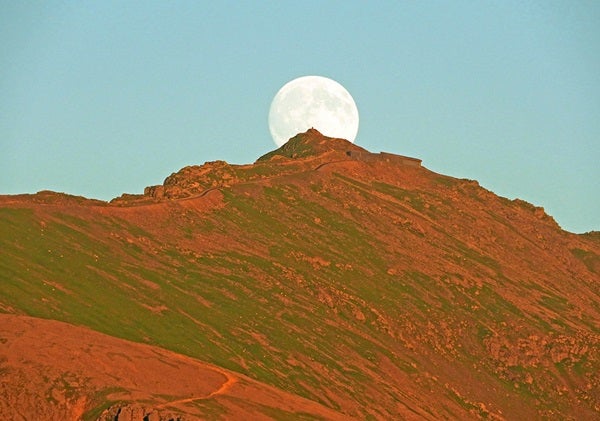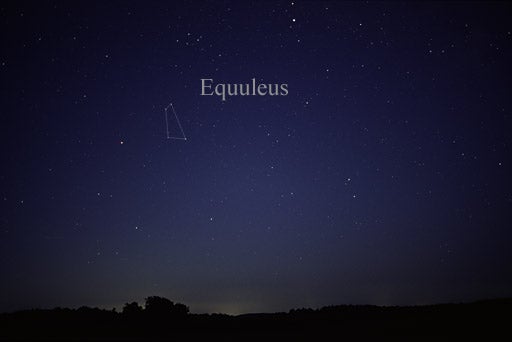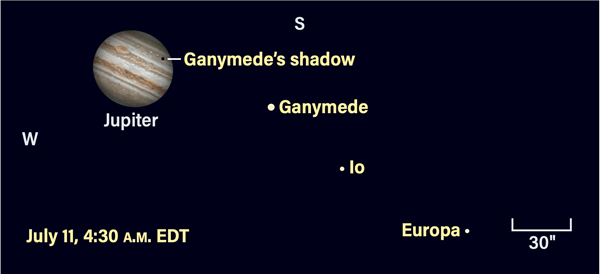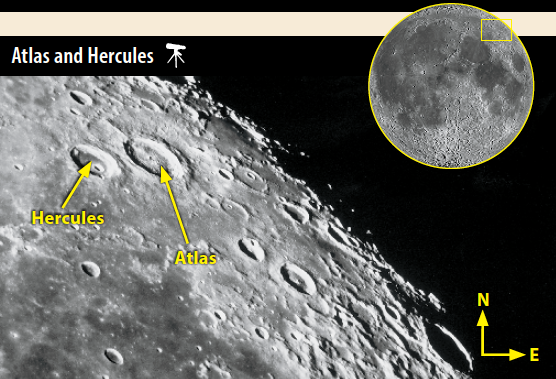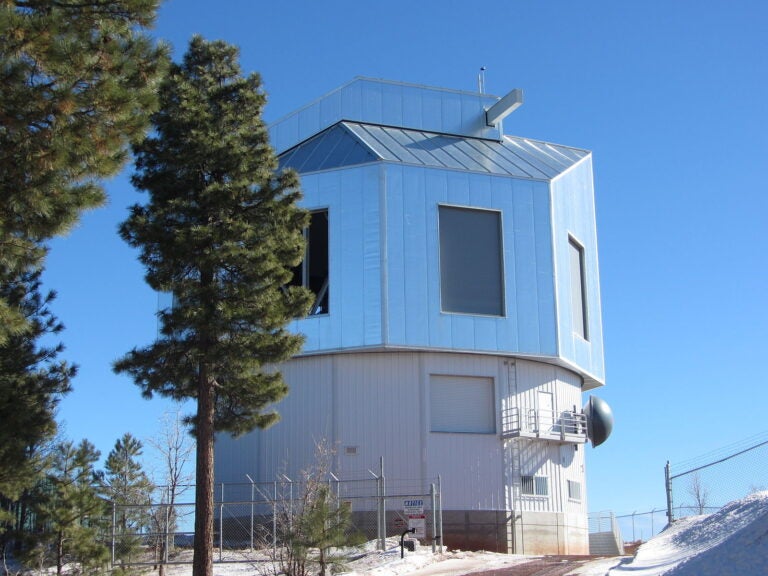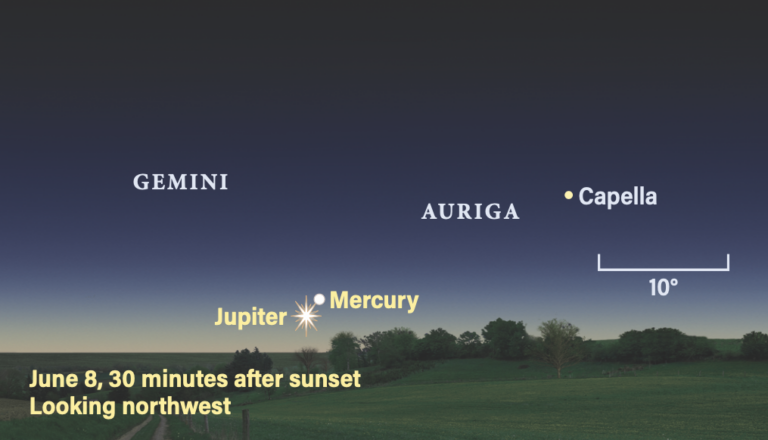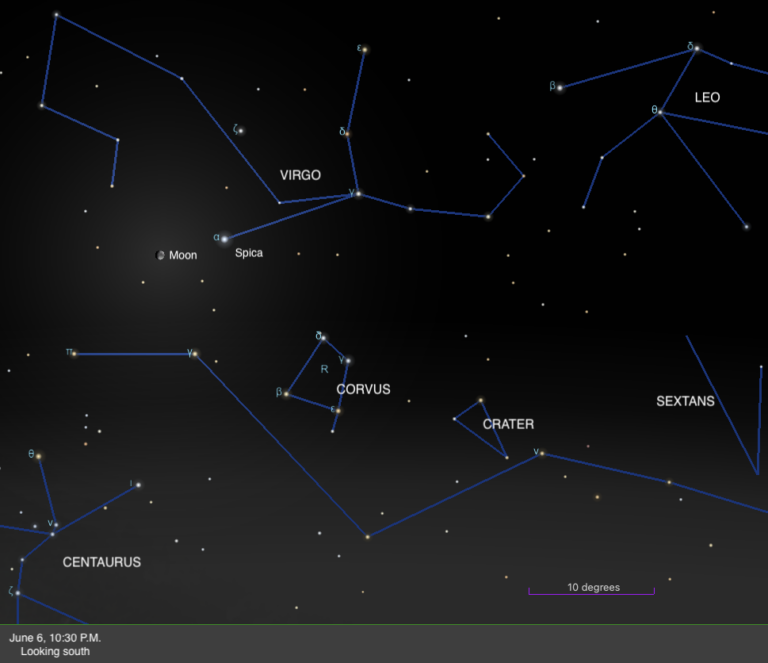Friday, July 8
High in the east after sunset are the constellations Lyra, Scutum, and Vulpecula. These are home to our three targets for tonight, which together form a pattern that Astronomy columnist Phill Harrington calls Scotty’s Triangle in honor of longtime deep-sky expert and astronomy enthusiast Walter Scott Houston.
Lyra is well known for its bright star Vega, which blazes at magnitude 0 and will one day in the far future stand near Earth’s North Celestial Pole, making it the North Star. Vega is also part of the large asterism the Summer Triangle, a favorite of warm-weather observers. Just over 6.5° southeast of Lyra is the famous Ring Nebula, cataloged as M57. This planetary nebula is magnitude 8.8, so it can be seen in binoculars or a telescope. If dropping down from Vega proves challenging, instead look halfway between 3rd-magnitude Sheliak (Beta [β] Lyrae) and Sulafat (Gamma [γ] Lyrae) to find your quarry.
The second point in Scotty’s Triangle is another famous planetary nebula: the Dumbbell (M27). At magnitude 7.5, it’s slightly brighter than the Ring, and lies in Vulpecula the Fox. To find it, Harrington advises looking 3.2° due north of magnitude 3.5 Gamma Sagittae, the tip of Sagitta the Arrow. Unlike the Ring Nebula, which is round, the Dumbbell has two distinct lobes (like its namesake), although you’ll need 16×70 binoculars or larger — or a telescope — to make out the tapering in the object’s center.
The third and final target tonight isn’t a planetary nebula but an open cluster: M11, also known as the Wild Duck Cluster. Spanning about 14′, M11 glows an easy-to-enjoy magnitude 6.3 and has been called one of our galaxy’s richest open clusters. To find it, Harrington recommends starting in Aquila the Eagle. Draw a line from bright Altair (also part of the Summer Triangle) through Lambda (λ) Aquilae, then continue through 12 Aquilae (just southwest of Lambda) and follow it as it curves through Eta (η) Scuti to the west. M11 sits farther along this line, 1.5° west-southwest of Eta Sct.
Sunrise: 5:39 A.M.
Sunset: 8:31 P.M.
Moonrise: 3:05 P.M.
Moonset: 1:17 A.M.
Moon Phase: Waxing gibbous (67%)
*Times for sunrise, sunset, moonrise, and moonset are given in local time from 40° N 90° W. The Moon’s illumination is given at 12 P.M. local time from the same location.
Saturday, July 9
There’s still time to enjoy all the major planets before sunrise if you have a clear eastern horizon. Twenty minutes before the Sun peeks above the horizon, Mercury sits just 3° high in the east. Although it may be low, it’s bright, now shining at magnitude –1.5. Nearly 19° to its west, in Taurus, is Venus (magnitude –3.9). Keep moving west and you’ll land on Mars, now nearly 47° from Venus. The Red Planet has just crossed from Pisces into Aries and shines at magnitude 0.4. It will brighten another 0.2 magnitude by month’s end. It now shares the constellation with Uranus, which lies just over 15° east of Mars. Uranus’ dim magnitude 5.8 disk requires binoculars or a telescope to pick out — the earlier you look, the better, as it will be quickly lost in the brightening sky.
Magnitude –2.5 Jupiter sits nearly 25° west of Mars, with distant planet Neptune just over 12.5° to its west. Like Uranus, Neptune is too faint to see with the naked eye, glowing at magnitude 7.7 about 7.5° south-southeast of the Circlet of Pisces. Finally, magnitude 0.4 Saturn is almost 44° west of Jupiter, capping off our morning planetary parade.
Sunrise: 5:40 A.M.
Sunset: 8:30 P.M.
Moonrise: 4:19 P.M.
Moonset: 1:46 A.M.
Moon Phase: Waxing gibbous (77%)
Sunday, July 10
After moonset this morning, early risers (or those up very late!) may easily recognize the Great Square of Pegasus high in the eastern sky. But Pegasus isn’t the only horse-themed constellation — just southwest of the Winged Horse is another equine figure: Equuleus the Foal.
Many people haven’t heard of this constellation, which seems reasonable because it has no particularly bright stars, no meteor shower, and no Messier objects. In fact, it’s the second smallest constellation there is, ranking 87th out of 88. But for those who love a naked-eye challenge, Equuleus is just waiting to be found this morning; here’s how to do it.
First, find Enif (Epsilon [ϵ] Pegasi), which denotes Pegasus’ nose or head. This magnitude 2.4 star sits in southwestern Pegasus. From Enif, look 7° due west — the magnitude 3.9 star you’ll find there is Alpha (α) Equulei, the Foal’s brightest star. It’s also called Kitalpha and is a binary pair so tight that it cannot be visually split.
The rest of the constellation’s stars are north and west of Alpha, and there are only three more with Greek designations: Beta, Delta (δ), and Gamma. Together with Kitalpha, these stars form Equuleus’ head and shoulders, the only parts of the Foal represented in the sky.
Sunrise: 5:41 A.M.
Sunset: 8:30 P.M.
Moonrise: 5:37 P.M.
Moonset: 2:20 A.M.
Moon Phase: Waxing gibbous (86%)
Monday, July 11
Jupiter is a bright magnitude –2.5 point of light in far northwestern Cetus the Whale this morning, east of the Circlet of Pisces. Rising around midnight, the gas giant is joined by its four Galilean moons, which sometimes cross its face along with their shadows. Pull out your telescope and you’ll see that this morning, Ganymede appears closest to Jupiter’s eastern limb before sunrise. This moon’s dark shadow will cross the southern regions of the planet starting at 3:55 A.M. EDT. Depending on your location, the Sun may rise before the shadow slips off cloud tops, which occurs just before 7 A.M. EDT (already in daylight on the East Coast and for much of the Midwest as well).
As Ganymede’s shadow meanders across the planet, all four moons stretch out to the east. In order from closest to farthest, they are Ganymede, Io, Europa, and Callisto. If today isn’t favorable, you can come back tomorrow morning to enjoy a transit of Europa. The icy moon moves onto Jupiter’s disk at 3:50 A.M. EDT, sliding off less than two hours later. Io (closest) and Ganymede are now off to Jupiter’s west, while Callisto still sits far to the east.
Sunrise: 5:41 A.M.
Sunset: 8:30 P.M.
Moonrise: 6:53 P.M.
Moonset: 3:04 A.M.
Moon Phase: Waxing gibbous (94%)
Tuesday, July 12
Asteroid 4 Vesta is stationary against the background stars at 2 A.M. EDT. Early morning is the best time to view this bright main-belt world; it rises just before midnight and by two hours before sunrise, Vesta is some 35° high in the south. Currently around magnitude 7, Vesta is actually the brightest (most reflective) asteroid in the main belt; however, it’s also currently some 136 million miles (220 million kilometers) from Earth. At its brightest, Vesta can reach a naked-eye magnitude of 5.
You’ll find Vesta currently in Aquarius, which sits in the southern sky this morning. The asteroid is just 3° northwest of magnitude 3.3 Skat, also cataloged as Delta Aquarii. Vesta remains in this region all month, sliding southwest and away from the star in late July, ending the month about 4.5° west-southwest of Skat. Check back every few nights to watch its progress.
Sunrise: 5:42 A.M.
Sunset: 8:29 P.M.
Moonrise: 8:04 P.M.
Moonset: 3:59 A.M.
Moon Phase: Waxing gibbous (98%)
Wednesday, July 13
The Moon reaches perigee, the closest point to Earth in its orbit, at 5:06 A.M. EDT. At that time, it will sit 221,993 miles (357,263 km) from our planet.
Less than 12 hours later, Full Moon occurs at 2:38 P.M. EDT. That means this month’s Full Moon is a Super Moon — the unofficial term for a Full Moon that occurs at or around perigee, when our satellite looks biggest and brightest. You may feel like you’ve read that term a lot this year — and it’s true. July’s Super Moon is 2022’s third Super Moon in a row, and it won’t be the last. We’ve got one more Super Moon in August to cap off the run. According to astrophysicist and eclipse expert Fred Espenak, we won’t get another until July 2023.
July’s Full Moon is also known as the Buck Moon. Like all Full Moons, it rises opposite the Sun in the sky, roughly around sunset, and will remain visible until sunrise. Our satellite shines brightly inside the handle of the Teapot asterism in Sagittarius, arcing through the southern sky overnight. For those in the western U.S. and Canada, the Moon will occult magnitude 3.3 Tau (τ) Sagittarii — you can check the International Occultation Timing Association’s page on the event to see whether it’s visible from your location.
Sunrise: 5:43 A.M.
Sunset: 8:29 P.M.
Moonrise: 9:04 P.M.
Moonset: 5:06 A.M.
Moon Phase: Full
Thursday, July 14
Thanks to libration — the apparent “nodding” motion of the Moon as it bobs up and down in its orbit, which is slightly tilted with respect to Earth — tonight we get a great view along the northern limb. Let’s focus on a set of flat-floored craters just west of the lunar north pole (east on the sky): Cremona, Brianchon, Pascal, and Sylvester. All are named for mathematicians.
The lunar landscape will look almost three-dimensional through your telescope eyepiece, thanks to the shadows stretching away from each feature. Take some time to enjoy the detail strewn across this rugged terrain. Just south of Cremona is the prominent crater Pythagoras, which stretches 80 miles (129 km) across and, unlike the others, does boast a central peak — in fact, there are three, which rise nearly 2 miles (3km) high. The floor of this crater sits some 3 miles (4.8 km) below its rim.
Sunrise: 5:43 A.M.
Sunset: 8:28 P.M.
Moonrise: 9:51 P.M.
Moonset: 6:22 A.M.
Moon Phase: Waning gibbous (98%)
Friday, July 15
The Moon passes 4° due south of Saturn at 4 P.M. EDT. You can catch both in the early-morning sky well before dawn — Saturn rises in Capricornus on Thursday around 10 P.M. local time and, like the Moon, is visible until sunrise. The ringed planet, which glows at magnitude 0.4, sits less than 1.5° north of Deneb Algedi. This morning, the Moon still floats some 9.7° southwest of Saturn an hour before sunrise.
Saturn is currently moving retrograde (west) against the background stars, approaching opposition next month. Its disk appears 18″ across, with its rings stretching roughly 42″. The planet’s largest, brightest moon, Titan, lies 2.6′ west; see if you can spot its magnitude 8.5 glow amid the bright moonlight. Saturn’s smaller, fainter moons will likely be too washed out by the nearby Moon to easily catch.
Check back late this evening to see that our satellite has now slid to a point 6° southwest of Saturn, rising about 30 minutes after the planet and roughly an hour and a half before midnight.
Sunrise: 5:44 A.M.
Sunset: 8:28 P.M.
Moonrise: 10:29 P.M.
Moonset: 7:42 A.M.
Moon Phase: Waning gibbous (94%)

